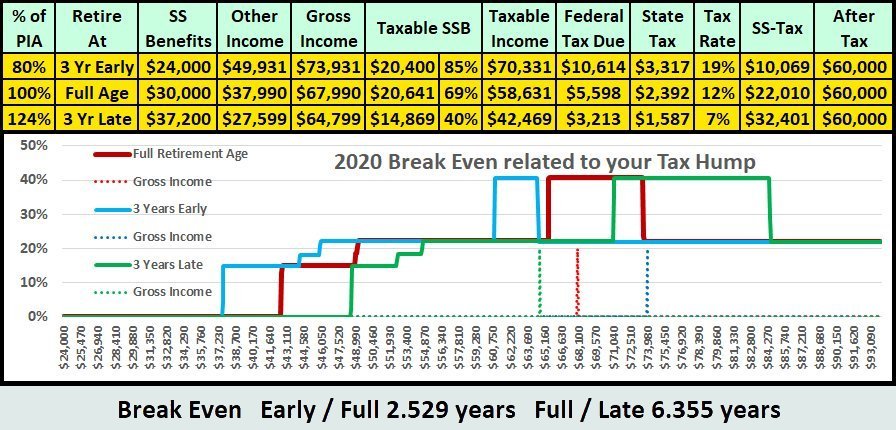Break EvenThe Social Security Benefit breakeven concept is often misrepresented when you attend one of those “free dinners”. You always get 80% of your Social Security benefits when you retire 3 years before your full retirement age, so the Break Even calculation will always be 12 years when you only look at the difference in the total benefit levels you are getting from the Government. BUT, I think the comment that was told to me at one of those free dinners actually described it best.
So, ask yourself a simple question: If the Government is going to give you $500 a month less every month for the remainder of your life, are you going to lower your retirement lifestyle by $6,000 a year? If the answer to that question is NO, where will the extra money come from? Our assumption for the rest of this Break Even page is that you will supplement your lower Social Security Benefit with additional taxable income from larger IRA withdrawals or a part time job or ... The proper way to look at Break Even is to look at the “Net” amount of income you are getting from "The Federal Government" after taxes! In all of the following examples, when you are only looking at the Gross
Social Security Benefits that you are getting from the government, the
breakeven calculations when you retire 3 years early and get 80% of the
Full Retirement Age benefit will be:
( 80% x 3 ) 240% / 20% ( 100% - 80% ) = 12 years SO, let's take a look at the breakeven results when you do the calculations on your NET Government income, Social Security minus Federal, State and Local taxes! 
The annual tax year COLA adjustments are 1.3%, 5.9% and 8.7% for tax years 2021 to 2023 while the Hi Low Lifestyle adjustments are just personal guesses. Note how size and positions of the tax humps as compared to the locations of the dotted vertical tick marks change when the tax year illustrates inflation based on the your personal choice for a higher or lower retirement lifestyle. And pay particular attention to the breakeven calculations below each image. The breakeven calculations that are based on the SS-Tax column, Net Government Income, are nowhere near the 12 year and 12.5 year calculations that were based on your Gross Social Security Benefits! The first thing to notice about all of these images is that Marginal Tax Humps increase in size as displayed from left to right for 3yr Early, Full Age, and 3yr Late retirement ages. Even more important, notice how the gross income dotted lines appear in reverse order, 3yr Late, Full Age, then 3yr Early. The earlier you retire, the more additional income you will need, creating a higher gross income levels and higher taxes. When the necessary gross income tick marks are pushed beyond your Social Security Sweet Spot, taxation increases which makes your net ratios even lower which also moves your breakeven lower. Your free dinner salesman will say 12 years while the after Federal, State, and Local Tax example only says 3.18 years! Before Tax Gov (25600 x 3) 76800 / 6400 (32000 - 25600) = 12 years After Tax Gov (12048 x 3) 36144 / 11360 (23408 - 12048) = 3.18 years How do you want to look at Break Even?When you look at these numbers from the viewpoint of living your desired retirement lifestyle, retiring 3 Years Early instead of 3 Years Late will provide you with $14,480 less initially tax free Social Security each year which you will have to supplement with an additional $22,317 yearly withdraw from your IRA so you can also pay an additional $8,237 extra Federal, State, and Local income taxes! So, how do you want to look at the concept of Break Even? Do you want to view it from the Gross amount of SS that the Government is giving you, OR, do you want to look at the Net amount of money you are getting from the Government after take back a larger amount of your Social Security as Taxes?
 Now that we have a reasonable estimate of your Personal Social Security benefit level, let's examine where your retirement money might come from so that you can start planning how to achieve these goals. Next - Your retirement income sources! |
||||||||||||||||||||||||||||||||||||||||||||||